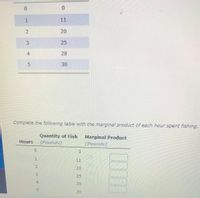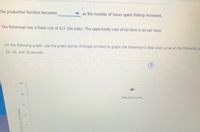
ENGR.ECONOMIC ANALYSIS
14th Edition
ISBN: 9780190931919
Author: NEWNAN
Publisher: Oxford University Press
expand_more
expand_more
format_list_bulleted
Question
thumb_up100%
A commercial fisherman notices the following relationship between hours spent fishing and the quantity of fish caught:
|
Hours
|
Quantity of Fish
|
|---|---|
|
(Pounds)
|
|
| 0 | 0 |
| 1 | 11 |
| 2 | 20 |
| 3 | 25 |
| 4 | 28 |
| 5 | 30 |
Complete the following table with the marginal product of each hour spent fishing.
|
Hours
|
Quantity of Fish
|
Marginal Product
|
|---|---|---|
|
(Pounds)
|
(Pounds)
|
|
| 0 | 0 | |
|
|
||
| 1 | 11 | |
|
|
||
| 2 | 20 | |
|
|
||
| 3 | 25 | |
|
|
||
| 4 | 28 | |
|
|
||
| 5 | 30 | |
Graph #1
On the following graph, use the blue points (circle symbol) to graph the fisherman's production function.
(graph #1 blue point = Prodution function)
The production function becomes ( flatter , steeper ) ? as the number of hours spent fishing increases.
The fisherman has a fixed cost of $12 (his pole). The opportunity cost of his time is $6 per hour.
Graph #2
On the following graph, use the green points (triangle symbol) to graph the fisherman's total-cost curve at the following quantities of fish: 0, 11, 20, 25, 28, and 30 pounds. ( green triangle symbol = total -cost curve )
True or False: The total-cost curve is increasing and convex because there are diminishing returns to fishing time.
True
0r
False

Transcribed Image Text:0.
0.
1
11
2.
20
25
4
28
30
Complete the following table with the marginal product of each hour spent fishing.
Quantity of Fish
(Pounds)
Marginal Product
(Pounds)
Hours
0.
0.
1
11
20
25
4.
28
30

Transcribed Image Text:The production function becomes
▼ as the number of hours spent fishing increases.
The fisherman has a fixed cost of $12 (his pole). The opportunity cost of his time is $6 per hour.
On the following graph, use the green points (triangle symbol) to graph the fisherman's total-cost curve at the following g
25, 28, and 30 pounds.
42
36
Total-Cost Curve
30
24
18
Total Cost of F ishing
Expert Solution
This question has been solved!
Explore an expertly crafted, step-by-step solution for a thorough understanding of key concepts.
This is a popular solution
Trending nowThis is a popular solution!
Step by stepSolved in 2 steps with 1 images

Knowledge Booster
Learn more about
Need a deep-dive on the concept behind this application? Look no further. Learn more about this topic, economics and related others by exploring similar questions and additional content below.Similar questions
- !arrow_forwardSuppose that Maria is starting a food ordering and delivery company. Customers order meals online. Employees prepare the meals and deliver them to customers. Maintenance of the online platform for ordering meals costs the company $5/day. The company also rents spave where orders are prepared. Rent costs $50/day. To make the deliveries, the business also rents two delivery cars the cost $10/day. The costs of ingredients for preparing different numbers of meals are $50. Maria also has to hire between 0-10 workers to buy ingredients, prepare meals, and deliver the orders. She pays them $120/day. The first two columns of the table below shows how many meals different number of workers can prepare and deliver. Suppose that a minimum wage is introduced. To comply the new law, Maria has to start paying the workers $140/day. How many meals does the business have to deliver to earn the highest possible profit? Answer by filling out the table. Suppose that the price/meal Maria charges…arrow_forwardA measure calculated by taking the ratio of output to input.arrow_forward
- Beth is a hard-working college senior. One Saturday, she decides to work nonstop until she has answered 100 practice problems for her math course. She starts work at 8:00 AM and uses a table to keep track of her progress throughout the day. She notices that as she gets tired, it takes her longer to solve each problem. Time Total Problems Answered 8:00 AM 9:00 AM 40 10:00 AM 70 11:00 AM 90 Noon 100 Use the table to answer the following questions. The marginal, or additional, gain from Beth's first hour of work, from 8:00 AM to 9:00 AM, is problems. The marginal gain from Beth's third hour of work, from 10:00 AM to 11:00 AM, is problems. Later, the teaching assistant in Beth's math course gives her some advice. "Based on past experience," the teaching assistant says, "working on 35 problems raises a student's exam score by about the same amount as reading the textbook for 1 hour." For simplicity, assume students always cover the same number of pages during each hour they spend reading.arrow_forwardthe second picture with the graph is part 2 of the first.arrow_forwardPlease solve Max in 30-45 minutes thank u and no reject. Please send the solution thank u... Chapter Microeconomicsarrow_forward
- Total product (meals per hour) 20 TP 16 12 2. 4 5 Quantity of labor (workers) The figure shows the total product curve for the Fruit Bowl food truck. If production increases from 19 to 20 meals per hour, the marginal product is in the range where it and the marginal product the average product. A) reaches a maximum; equals B) increases; is greater than C) decreases; is greater than D) increases; is less than E) decreases; is less than 24arrow_forwardFirst graph the related points, shown in the picture, the part I am confused in doing is how to find the marginal product of each of the first four workers and what the marginal product of each of the second workers.I thought the first set would be 7 and the second set would be 5 but then I noticed I need to do it based on the graph.How would I get both questions via the graph?arrow_forwardRaphael is a hard-working college senior. One Saturday, he decides to work nonstop until he has answered 100 practice problems for his math course. He starts work at 8:00 AM and uses a table to keep track of his progress throughout the day. He notices that as he gets tired, it takes him longer to solve each problem. Time Total Problems Answered 8:00 AM 9:00 AM 40 10:00 AM 70 11:00 AM 90 Noon 100 Use the table to answer the following questions. The marginal, or additional, gain from Raphael's first hour of work, from 8:00 AM to 9:00 AM, is problems. The marginal gain from Raphael's third hour of work, from 10:00 AM to 11:00 AM, is problems. Later, the teaching assistant in Raphael's math course gives him some advice. "Based on past experience," the teaching assistant says, "working on 15 problems raises a student's exam score by about the same amount as reading the textbook for 1 hour." For simplicity, assume students always cover the same number of pages during each hour they spend…arrow_forward
- Suppose that Shen is a diligent hard - working first- year college student. One Friday, he decides to start the day by working through 300 practice problems to study for the econometrics class. Using a table to track his progress throughout the day, he notices that as the hours pass, takes him longer to solve the problems.Use the table to answer the following questions.arrow_forwardGraph the change on the production function when a firm decreases its labourarrow_forwardConsider a production process where flowers are grown (the output) using gardeners (labor) and greenhouses (capital). The quantity of flowers grown per day with various combinations of labor and capital are shown in the table. Fill in the marginal product of labor in the table below. (Enter your responses as integers).arrow_forward
arrow_back_ios
SEE MORE QUESTIONS
arrow_forward_ios
Recommended textbooks for you

 Principles of Economics (12th Edition)EconomicsISBN:9780134078779Author:Karl E. Case, Ray C. Fair, Sharon E. OsterPublisher:PEARSON
Principles of Economics (12th Edition)EconomicsISBN:9780134078779Author:Karl E. Case, Ray C. Fair, Sharon E. OsterPublisher:PEARSON Engineering Economy (17th Edition)EconomicsISBN:9780134870069Author:William G. Sullivan, Elin M. Wicks, C. Patrick KoellingPublisher:PEARSON
Engineering Economy (17th Edition)EconomicsISBN:9780134870069Author:William G. Sullivan, Elin M. Wicks, C. Patrick KoellingPublisher:PEARSON Principles of Economics (MindTap Course List)EconomicsISBN:9781305585126Author:N. Gregory MankiwPublisher:Cengage Learning
Principles of Economics (MindTap Course List)EconomicsISBN:9781305585126Author:N. Gregory MankiwPublisher:Cengage Learning Managerial Economics: A Problem Solving ApproachEconomicsISBN:9781337106665Author:Luke M. Froeb, Brian T. McCann, Michael R. Ward, Mike ShorPublisher:Cengage Learning
Managerial Economics: A Problem Solving ApproachEconomicsISBN:9781337106665Author:Luke M. Froeb, Brian T. McCann, Michael R. Ward, Mike ShorPublisher:Cengage Learning Managerial Economics & Business Strategy (Mcgraw-...EconomicsISBN:9781259290619Author:Michael Baye, Jeff PrincePublisher:McGraw-Hill Education
Managerial Economics & Business Strategy (Mcgraw-...EconomicsISBN:9781259290619Author:Michael Baye, Jeff PrincePublisher:McGraw-Hill Education


Principles of Economics (12th Edition)
Economics
ISBN:9780134078779
Author:Karl E. Case, Ray C. Fair, Sharon E. Oster
Publisher:PEARSON

Engineering Economy (17th Edition)
Economics
ISBN:9780134870069
Author:William G. Sullivan, Elin M. Wicks, C. Patrick Koelling
Publisher:PEARSON

Principles of Economics (MindTap Course List)
Economics
ISBN:9781305585126
Author:N. Gregory Mankiw
Publisher:Cengage Learning

Managerial Economics: A Problem Solving Approach
Economics
ISBN:9781337106665
Author:Luke M. Froeb, Brian T. McCann, Michael R. Ward, Mike Shor
Publisher:Cengage Learning

Managerial Economics & Business Strategy (Mcgraw-...
Economics
ISBN:9781259290619
Author:Michael Baye, Jeff Prince
Publisher:McGraw-Hill Education